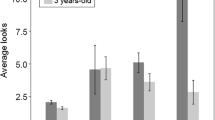Abstract
Social monitoring has been hypothesized to be an important component of primate social behavior. If the gaze direction of one animal can redirect the gaze of another, visual scanning of conspecifics can provide a more efficient means of locating food or predators than directly scanning the entire nonsocial environment. Social monitoring also allows distance regulation between members of a group, reducing the likelihood of agonistic encounters. Although assessment of gaze direction in freely moving primates is problematic, we were successful in assessing amounts of visual scanning among adult females of a captive, socially housed group of patas monkeys (Erythrocebus patas) using a focal sampling technique with on-the-dot recording (5-s sampling intervals). In study 1, relative amounts of scanning were assessed as subjects gazed at any other member of the group. Percentages of agreement between observers ranged from 80% to 92%, with corresponding κ values ranging from 0.74 to 0.92. In study 2, relative amounts of visual scanning were assessed so that specific targets of gaze were identified. The resultant data supported a long-standing prediction about the role of social monitoring in primate group dynamics. Lower-ranking animals gazed toward higher-ranking animals more often than vice versa. Although the specific cues eliciting social monitoring remain to be determined, visual attention in this social primate group appeared to be systematically related to hierarchical ranks, assessed by displacements. Minimally, these results suggest that patas monkeys structure their visual attention based on previous encounters with other members of their social group. While simple discrimination learning could account for these results, the demonstration of a systematic relationship between visual attention and primate social dynamics is relevant to current discussions of a primate’s understanding of conspecific gaze direction.
Similar content being viewed by others
Author information
Authors and Affiliations
Additional information
Received: 26 January 1998 / Accepted after revision: 29 March 1998
Rights and permissions
About this article
Cite this article
McNelis, N., Boatright-Horowitz, S. Social monitoring in a primate group: the relationship between visual attention and hierarchical ranks. Anim Cogn 1, 65–69 (1998). https://doi.org/10.1007/s100710050008
Issue Date:
DOI: https://doi.org/10.1007/s100710050008




